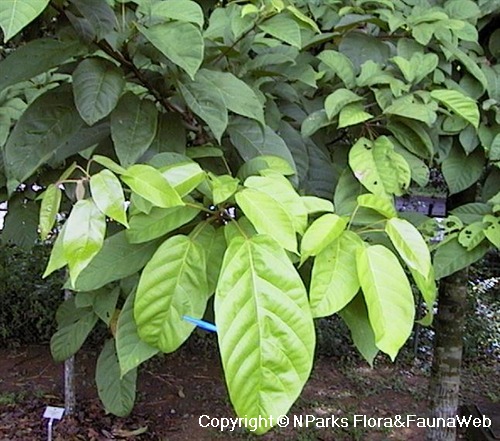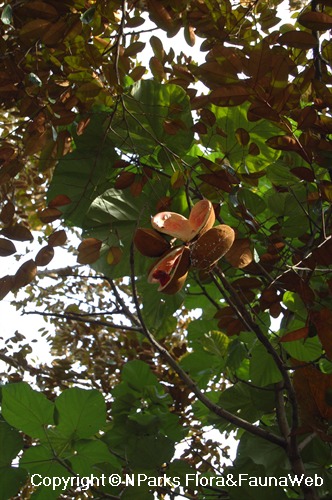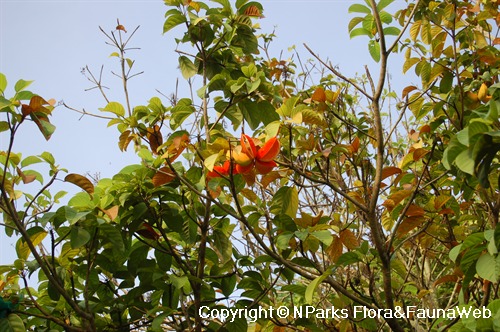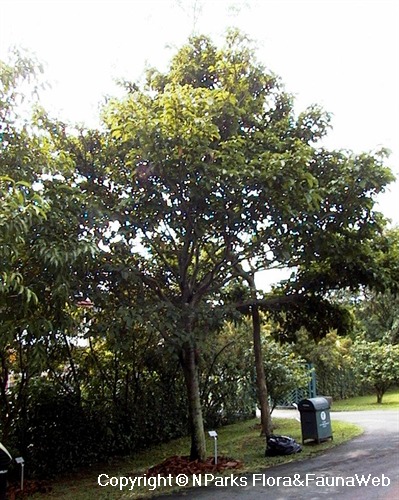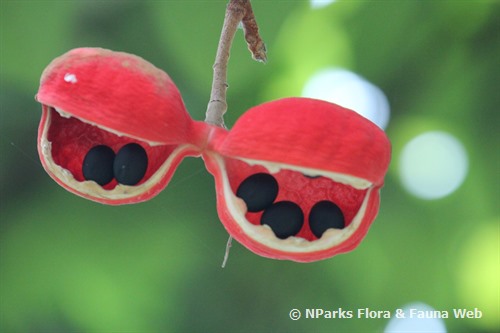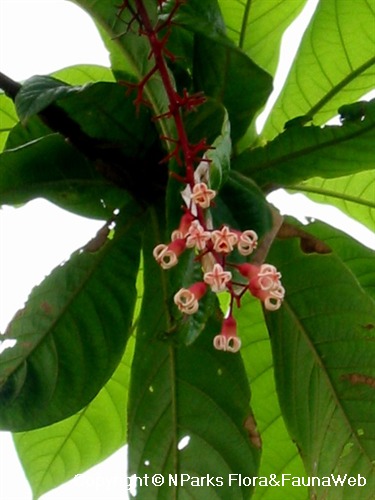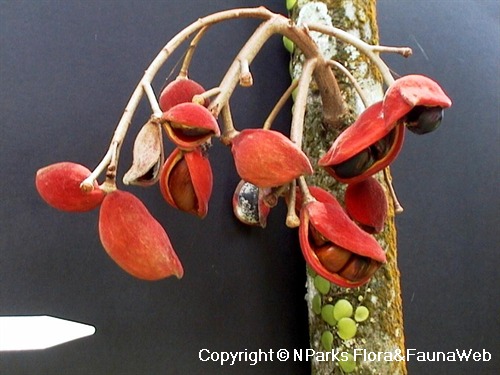
Back
Sterculia oblongata R. Br.
| Family Name: | Malvaceae |
| Synonyms: | Sterculia forbesii, Sterculia spectabilis, Sterculia kunstleri, Sterculia urceolata |
| Common Name: | Sterculia, Kalumpang |
Name
Classifications and Characteristics
| Plant Division | Angiosperms (Flowering Seed Plants) (Dicotyledon) |
|---|---|
| Plant Growth Form | Tree (Small (6m-15m)) |
| Lifespan (in Singapore) | Perennial |
| Mode of Nutrition | Autotrophic |
| Plant Shape | Conical |
| Maximum Height | 12 m |
| Tree or Palm – Trunk Diameter | 0 |
Biogeography
| Native Distribution | Malay Peninsula, Sumatra |
|---|---|
| Native Habitat | Terrestrial (Primary Rainforest, Secondary Rainforest) |
| Preferred Climate Zone | Tropical |
Description and Ethnobotany
| Others - Plant Morphology | Growth Form: Small evergreen tree with conical crown. Habitat: Occurs in open regions of tropical primary and secondary forests at low to medium altitudes. Trunk: Grey bark is smooth. Has linear lenticels (corky structures that allow oxygen to pass into the stem). Foliage: Leaves elliptic or oblong with entire leaf margin. Flowers: This species is monoecious, having male and female flowers on the same tree. Flowers are shaped like tea cups (urceolate) or bells (campanulate). The inflorescence is a panicle. Fruits: Fruits are dry, dehiscent fruits known as capsules. They are hollow, hairy and shaped like small mangoes (4 - 8 cm long, 3.5 cm wide). The yellow fruits gradually become red-orange. Fruits have 4 - 6 black, ellipsoid seeds (1 - 2.5 cm long). Landscaping: The bright red-orange fruits give this species an interesting look. It is can be planted in parks or function as a shade tree or roadside tree. Propagation: Propagate by seed or stem cuttings. Etymology: The genus "Sterculia" is named after the Roman god Sterculius, the god of manure. The reference is to the foul-smelling flowers of some species in this genus. The species epithet "oblongata" is a reference to the oblong leaves and fruits. |
|---|---|
| Ethnobotanical Uses | Edible Plant Parts : Edible Seeds Others: Food: Seeds are edible and said to taste like peas. They are consumed raw or roasted. Other: Fibres extracted from the bark are used to make rope, paper, hats, handbags, etc.. The wood can be used to make matchsticks or small pieces of furniture (eg., cabinets). |
Landscaping Features
| Desirable Plant Features | Ornamental Fruits |
|---|---|
| Landscape Uses | Suitable for Roadsides, Shade Providing Tree / Palm |
Fauna, Pollination and Dispersal
| Seed or Spore Dispersal | Abiotic (Gravity) |
|---|
Plant Care and Propagation
| Light Preference | Full Sun |
|---|---|
| Water Preference | Moderate Water |
| Plant Growth Rate | Moderate |
| Rootzone Tolerance | Fertile Loamy Soils, Well-Drained Soils |
| Propagation Method | Seed, Stem Cutting |
Foliar
| Foliage Retention | Evergreen |
|---|---|
| Mature Foliage Colour(s) | Green |
| Mature Foliage Texture(s) | Glossy / Shiny |
| Foliar Type | Simple / Unifoliate |
| Foliar Shape(s) | Non-Palm Foliage (Elliptical, Oblong) |
| Foliar Venation | Pinnate / Net |
| Foliar Margin | Entire |
| Foliar Apex - Tip | Acute |
| Foliar Base | Rounded / Obtuse |
| Leaf Area Index (LAI) for Green Plot Ratio | 3.0 (Tree - Intermediate Canopy) |
Non - Foliar and Storage
| Trunk Type (Non Palm) | Woody |
|---|---|
| Bark Colour(s) | Grey |
| Mature Bark Texture | Smooth |
| Root Type | Underground (Tap Root) |
Floral (Angiosperm)
| Flower & Plant Sexuality | Unisexual Flowers , Monoecious |
| Flower Colour(s) | Pink, Red, Yellow / Golden |
|---|
| Flower Symmetry | Radial |
| Individual Flower Shape | Urceolate / Urn-shaped |
| Inflorescence Type | Panicle |
| Flowering Period | Once Yearly |
Fruit, Seed and Spore
| Mature Fruit Colour(s) | Red |
|---|---|
| Fruit Classification | Simple Fruit |
| Fruit Type | Dehiscent Dry Fruit , Capsule |
Image Repository
Others
| Master ID | 1847 |
|---|---|
| Species ID | 3140 |
| Flora Disclaimer | The information in this website has been compiled from reliable sources, such as reference works on medicinal plants. It is not a substitute for medical advice or treatment and NParks does not purport to provide any medical advice. Readers should always consult his/her physician before using or consuming a plant for medicinal purposes. |

